Classen Rafael / EyeEm / Getty Images
Updated on October 22, 2018
Elapsed time is the amount of time that passes between the beginning and the end of an event. The concept of elapsed time fits nicely in the elementary school curriculum. Beginning in third grade, students should be able to tell and write time to the nearest minute and solve word problems involving addition and subtraction of time. Reinforce these essential skills with the following elapsed time word problems and games.
Elapsed Time Word Problems
These quick and easy elapsed time word problems are perfect for parents and teachers who want to help students practice elapsed time to the nearest minute with simple mental math problems. Answers are listed below.
- Sam and his mom arrive at the doctor’s office at 2:30 p.m. They see the doctor at 3:10 p.m. How long was their wait?
- Dad says dinner will be ready in 35 minutes. It’s 5:30 p.m. now. What time will dinner be ready?
- Becky is meeting her friend at the library at 12:45 p.m. It takes her 25 minutes to get to the library. What time will she need to leave her house to arrive on time?
- Ethan’s birthday party started at 4:30 p.m. The last guest left at 6:32 p.m. How long did Ethan’s party last?
- Kayla put cupcakes in the oven at 3:41 p.m. The directions say that the cupcakes need to bake for 38 minutes. What time will Kayla need to take them out of the oven?
- Dakota arrived at school at 7:59 a.m. He left at 2:33 p.m. How long was Dakota at school?
- Dylan started working on homework at 5:45 p.m. It took him 1 hour and 57 minutes to complete it. What time did Dylan complete his homework?
- Dad arrives home at 4:50 p.m. He left work 40 minutes ago. What time did Dad get off work?
- Jessica’s family is traveling from Atlanta, Georgia to New York by plane. Their flight leaves at 11:15 a.m. and should take 2 hours and 15 minutes. What time will their plane arrive in New York?
- Jordan got to football practice at 7:05 p.m. Steve showed up 11 minutes later. What time did Steve get to practice?
- Jack ran a marathon in 2 hours and 17 minutes. He crossed the finish line at 10:33 a.m. What time did the race start?
- Marci was babysitting for her cousin. Her cousin was gone for 3 hours and 40 minutes. Marci left at 9:57 p.m. What time did she start babysitting?
- Caleb and his friends went to see a movie at 7:35 p.m. They left at 10:05 p.m. How long was the movie?
- Francine got to work at 8:10 a.m. She left at 3:45 p.m. How long did Francine work?
- Brandon went to bed at 9:15 p.m. It took him 23 minutes to fall asleep. What time did Brandon fall asleep?
- Kelli had to wait in a long, slow-moving line to purchase a popular new video game that was just released. She got in line at 9:15 a.m. She left with the game at 11:07 a.m. How long did Kelli wait in line?
- Jaydon went to batting practice Saturday morning at 8:30 a.m. He left at 11:42 a.m. How long was he at batting practice?
- Ashton got behind on her reading assignment, so she had to read four chapters last night. She started at 8:05 p.m. and finished at 9:15 p.m. How long did it take Ashton to catch up on her assignment?
- Natasha has a dentist appointment at 10:40 a.m. It should last 35 minutes. What time will she finish?
- Mrs. Kennedy’s 3rd-grade class is going to the aquarium on a field trip. They are scheduled to arrive at 9:10 a.m. and leave at 1:40 p.m. How long will they spend at the aquarium?
Elapsed Time Games
Try these games and activities at home to help your children practice elapsed time.
Daily Schedule
Let your children keep track of their schedule and ask them to figure the elapsed time for each activity. For example, how long did your child spend eating breakfast, reading, taking a bath, or playing video games?
How Long Will It Take?
Give your kids practice with elapsed time by encouraging them to figure out how long daily activities take. For example, the next time you order a pizza online or by phone, you’ll probably be given an estimated delivery time. Use that information to create a word problem that’s relevant to your child’s life, such as, «It’s 5:40 p.m. now and the pizza shop says the pizza will be here at 6:20 p.m. How long will it take for the pizza to arrive?»
Time Dice
Order a set of time dice from online retailers or teacher supply stores. The set contains two twelve-sided dice, one with numbers representing the hours and the other with numbers representing minutes. Take turns rolling the time dice with your child. Each player should roll twice, then calculate the elapsed time between the two resulting dice times. (A pencil and paper will come in handy, as you’ll want to jot down the time of the first roll.)
Elapsed Time Word Problem Answers
- 40 minutes
- 6:05 p.m.
- 12:20 p.m.
- 2 hours and 2 minutes
- 4:19 p.m.
- 6 hours and 34 minutes
- 7:42 p.m.
- 4:10 p.m.
- 1:30 p.m.
- 7:16 p.m.
- 8:16 a.m.
- 6:17 p.m.
- 2 hours and 30 minutes
- 7 hours and 35 minutes
- 9:38 p.m.
- 1 hour and 52 minutes
- 3 hours and 12 minutes
- 1 hour and 10 minutes
- 11:15 a.m.
- 4 hours and 30 minutes
Word problems are an important part of math instruction because they show students how they can use the math they are learning in the classroom in real life. A skill they will be using constantly throughout their life!
For this reason, I try to make learning this skill as fun as possible so that students will be engaged enough to really learn and understand the concept!
Here are some of my favorite tips for teaching word problems!

- Use picture books – Model real-world problems using actual books. This is so easy to do with pretty much any picture book. All you need are pictures! While you’re reading, look for any changes with adding and subtracting in the pictures. For example: in Eric Carle’s The Very Hungry Caterpillar, you can point out the adding one concept using the food. This is a good start for helping students understand that word problems have a beginning, change, and an end. For modeling subtraction, I found this book One Big Pair of Underwear. It’s hilarious! The kids really liked the funny pictures and obviously, anything with underwear captures their attention.

- Think- Pair – Share – Solving word problems can be difficult for young students especially if they’re reluctant to read the words. One way you can help students overcome this challenge is with think-pair-share. Start by reading the word problem out loud. You may need to do this two or three times. Then, give students one minute to think about what they just read. Next. have students share with a partner what they just heard. Some questions they may discuss are:
- What do you know?
- What do you need to solve?
- How might you solve that?
This supports your little learners by helping “read” the world problem and it integrates with your listening and speaking standards.

- Use rewards – Motivate your students to complete word problems. You can use this FREE Word Problem pack to do that. When students complete a word problem, they simply color, stamp, or place a counter over a space. When they’ve completed a certain amount, they earn a reward of their choice. For example, if a student completes five word problems, then the student can take their shoes off.

- Making Movies – is another way I like to teach my students how to solve word problems. Have them close their eyes and visualize what is happening in the story. Is the information missing in the beginning, middle, or end of the story?

- DIY Word Problems – Create your own math word problems. Have students roll dice to create their own math word problems. This helps engage them in learning and gets them to work independently. You can grab these by clicking here!

- Get Hands-on -Use math manipulatives to model word problems. My favorite math manipulative is using an abacus. I model with one row the first part of the story. Then, I model the second part on the second row. Finally, I model the third part on the third row. Wherever the missing information is (beginning, middle, or end), we don’t model it, and this is where we show our answer. You can also use a tens frame with counters. This hands on manipulative organizes the information for kids to see and it’s an essential tool that will appear over and over again in K – 2.

- Play Games – There are so many benefits to doing this. You can read about those here. You can get extra practice with word problems using these games. I’ve made sure to create a balance with word problems that have a missing beginning, missing middle, and a missing end. There are some with a change and some that compare.
These activities have always been a hit in my classroom. Making learning fun is such a simple and great way to increase student engagement and learning outcomes!
What are your favorite ways to teach word problems? Let me know in the comments!

Reader Interactions
Solving word problems can be tricky at any grade. We know that students learn and grasp concepts differently so a plethora of resources is needed to meet the needs of each student.
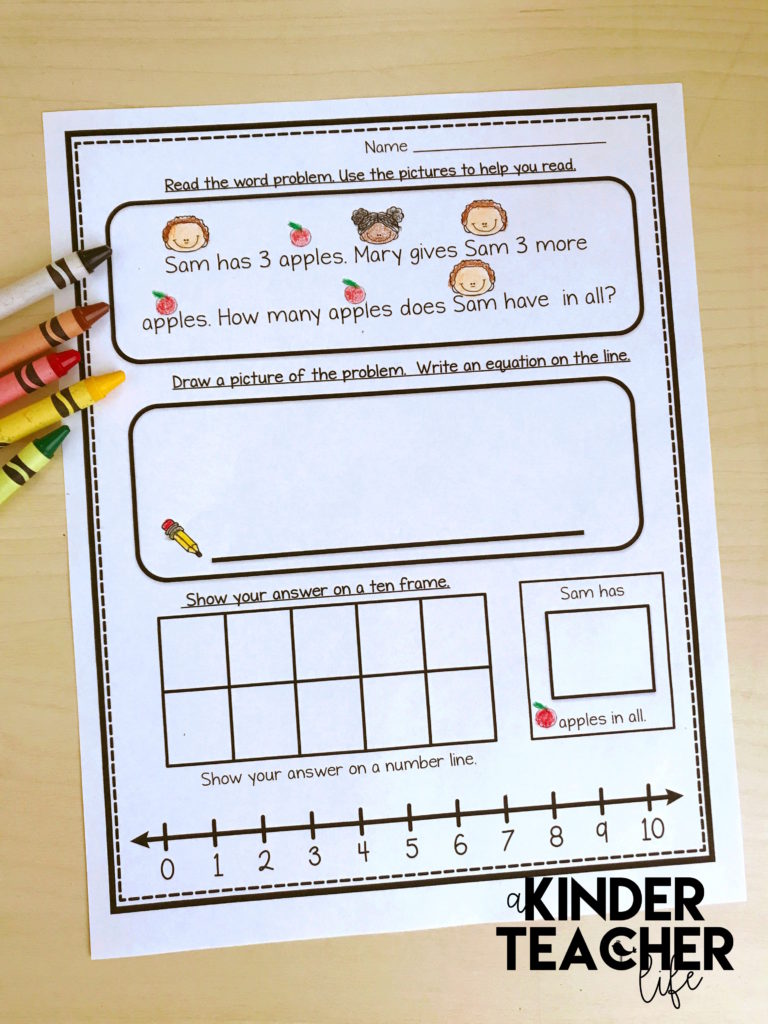
Teaching Word Problems to Primary Learners
How many times has this happened to you? You show students a word problem and give them time to solve it. You walk past their desk and glance at their papers. If the student’s answer is correct, you keep going. If it is incorrect, you stop and try to figure out how they got the answer they wrote. You think: Did they not understand the word problem? Did they add when they should have subtracted? Did they think about what makes sense because their answer doesn’t even make sense? Did they understand what they were reading? Is the answer wrong because they didn’t understand the question?
I asked myself those questions too! So, I made these Solving Math Word Problems Using Multiple Strategies worksheets to help students be more independent by supplying them with the resources they need to solve word problems!
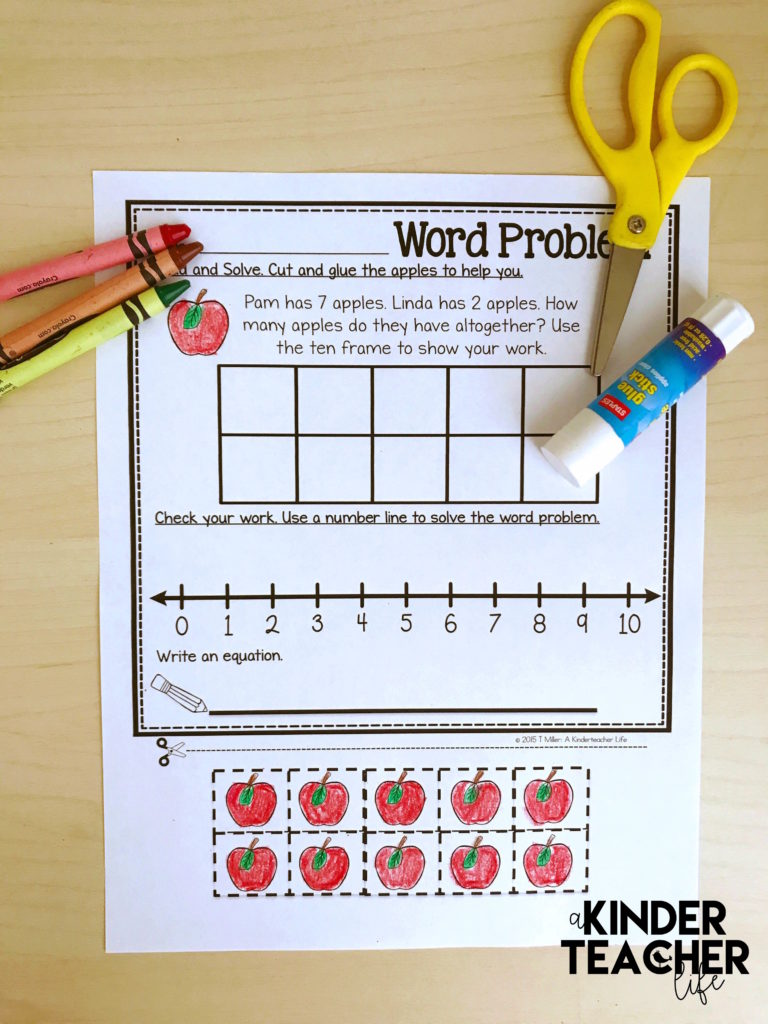
This resource works on so many levels. The word problems include visuals so students can read them independently and not spend too much time trying to decode what it says. There are 3 ways that students can solve a word problem: by drawing a picture, using a ten frame or a number line. This allows students to pick the strategy that they feel most confident to solve the problem. I ask my students to use 2 strategies to solve so they can check their work.
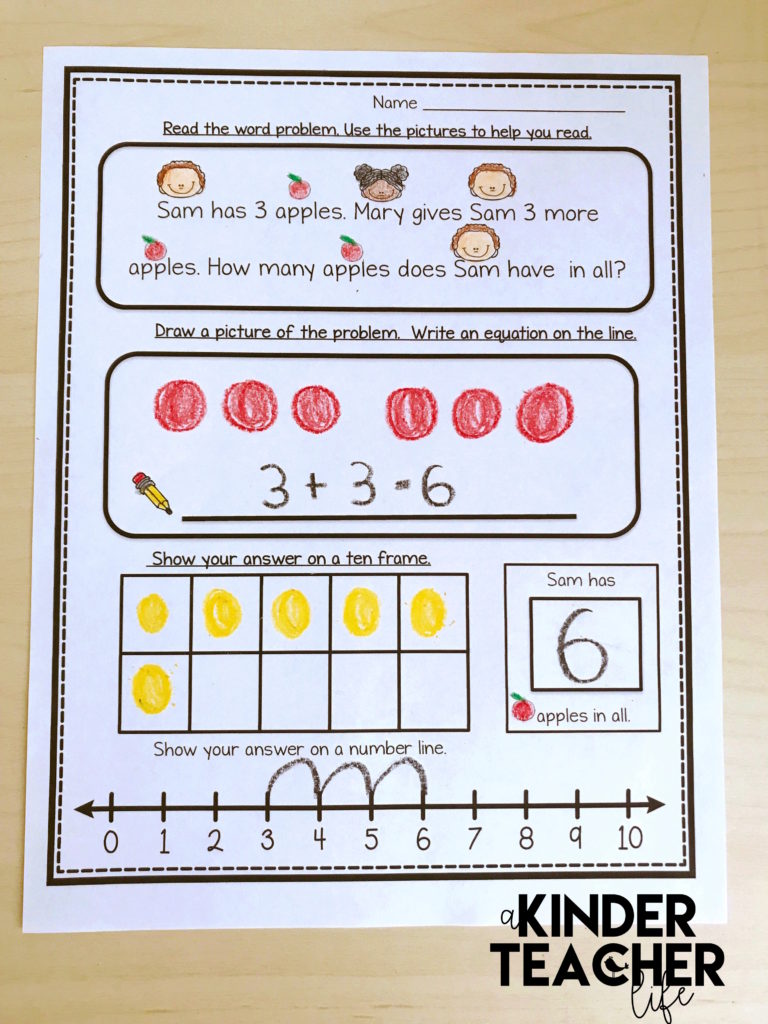
I really LOVE using these worksheets because you can see how students solved the problem. You can see where they made their mistake and can instruct them from there. You can see their preferred strategy. I LOVE that students can explain their thinking because they can see their thinking. It’s music to my ears! My students LOVE these worksheets because they feel confident that they can complete it on their own with little to no teacher help.
If you have students that are kinesthetic learners, switch out the pencils and crayons with math manipulatives!
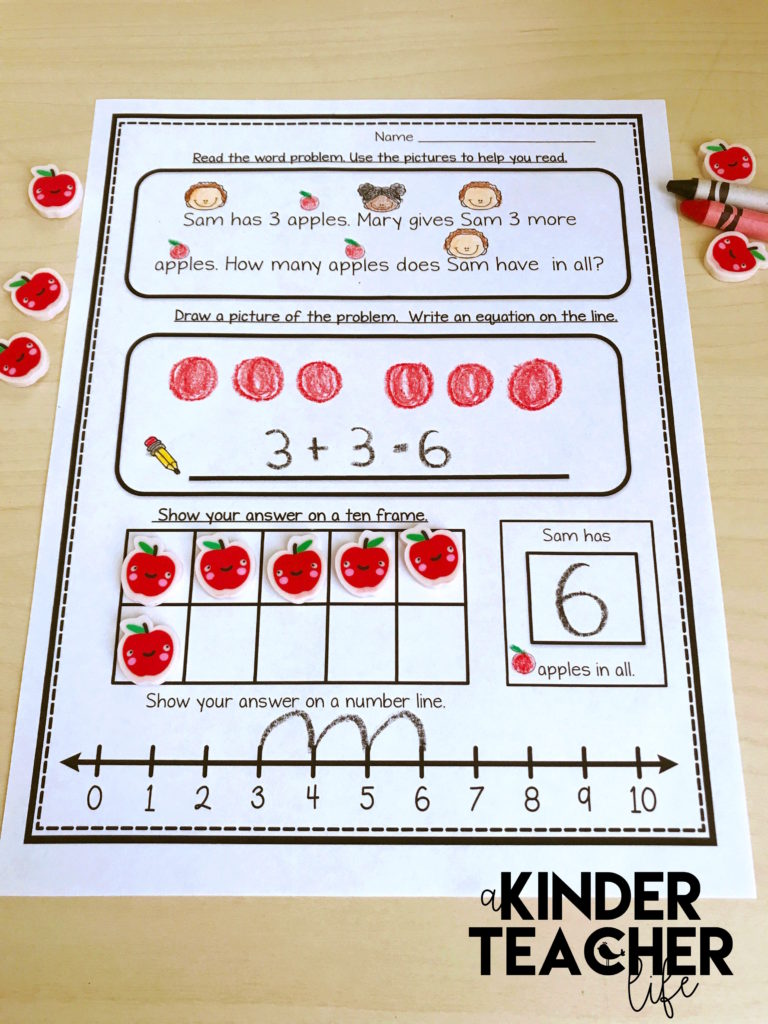
There are 22-word problems presented in a variety of layouts. I have included a template page so you can write your own word problems!
To get this resource, to go my TpT store or click on the image below:
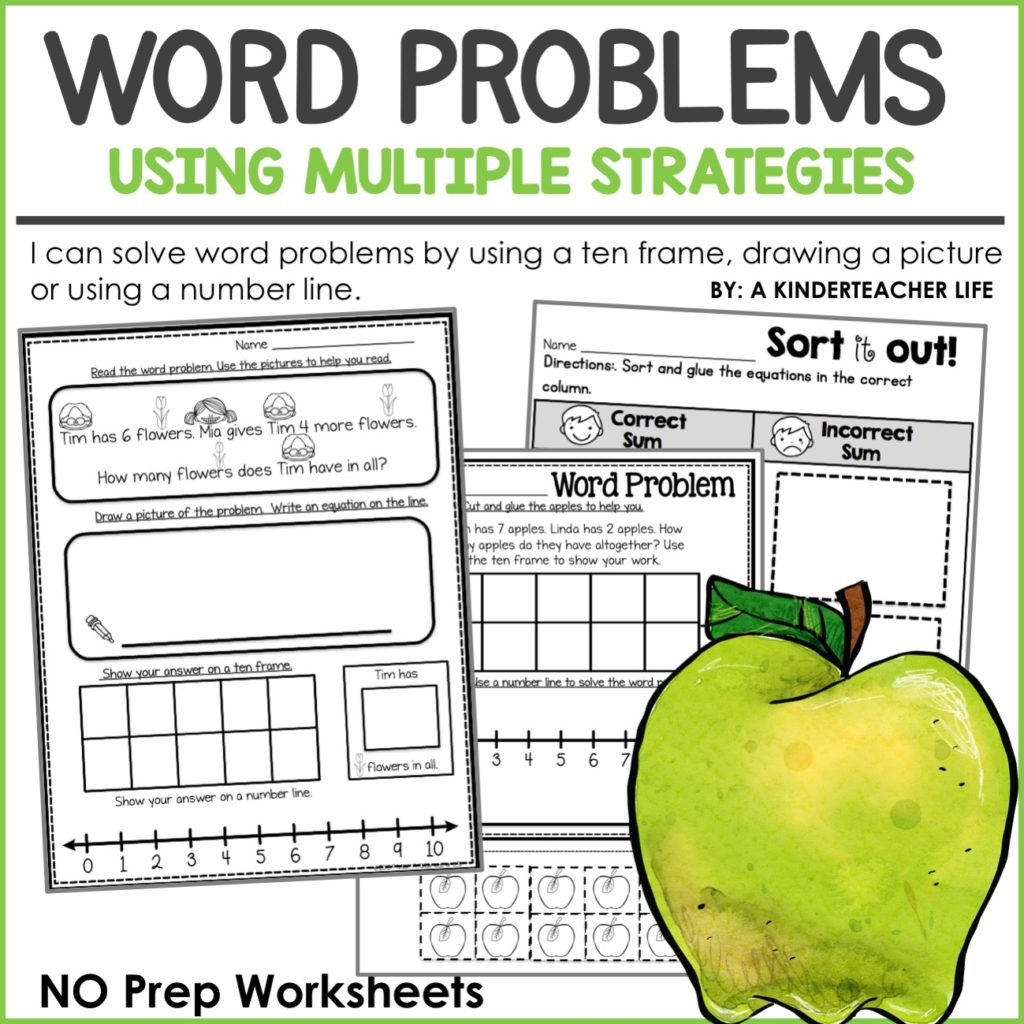
To keep word problems exciting, I use ones that are most appropriate for the season.
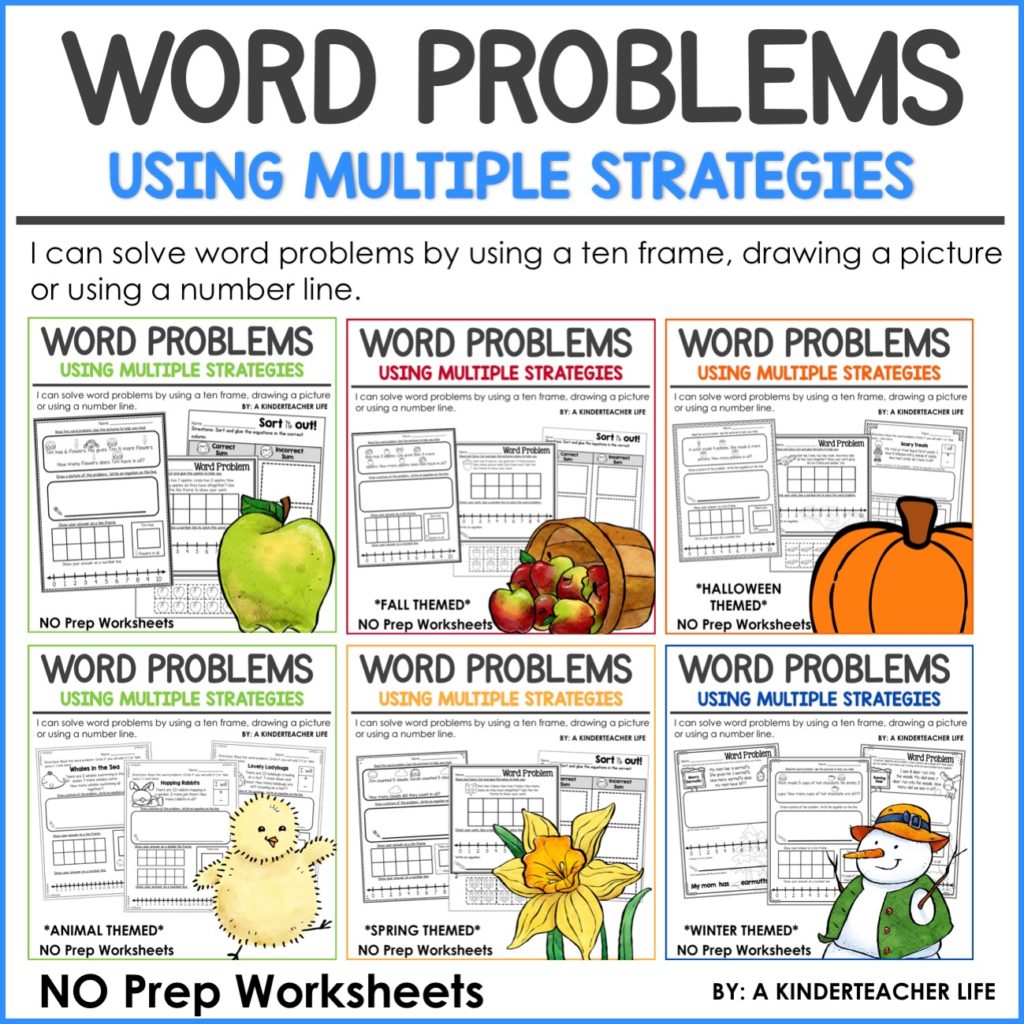
When Can I Use these Worksheets?
I have used these worksheets for different reasons. I have used them for morning work, homework, math warm-ups, math center (definitely a plus if you have math journals), sub work, or small group instruction.
Here’s a FREEBIE!
Here’s a solving math word strategies freebie! Click the image to go to my TpT store to download this resource.

What are some other ways you teach students to use math word problems? Let me know in the comments section.
If you want more hands-on math activities and ideas, check out my Pinterest Board Hands-on Math by clicking the image.
Pin for later!
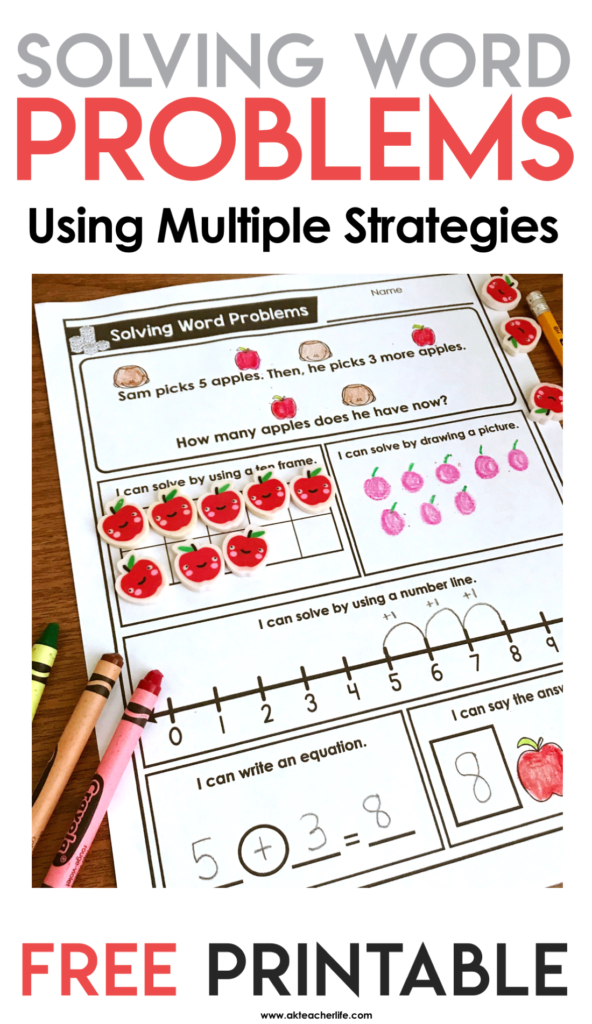
While you are here take a look at my Interactive Ten Frame resource! It’s a great way to teach students to read and represent numbers using a ten frame interactively!
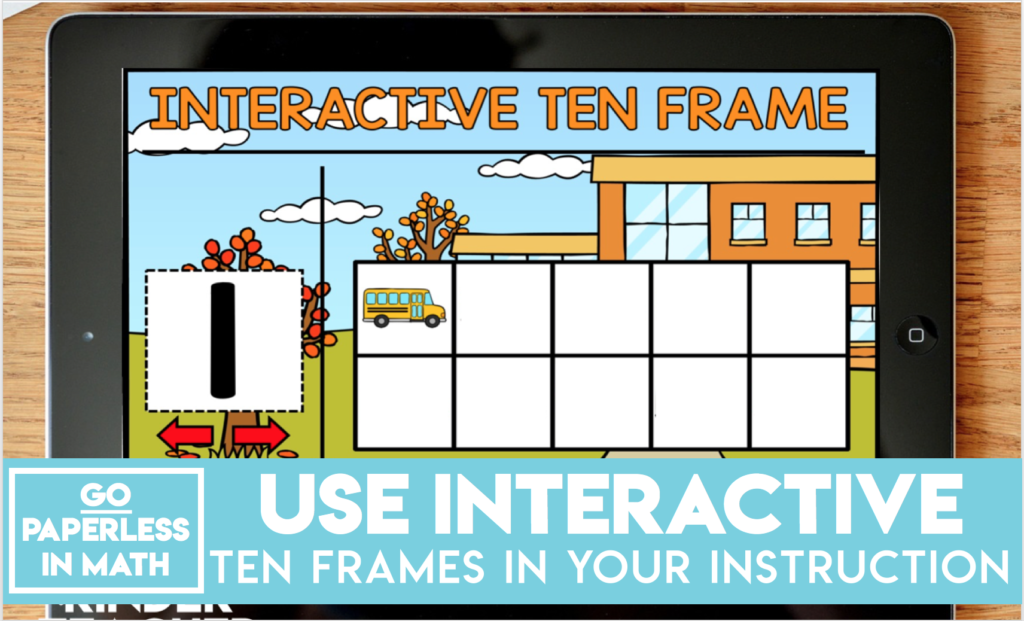
Happy Teaching,
Tee
This time of year can be tough, y’all. We need students to dig real deep to grasp all of the concepts that we teach them, but everyone is just TIRED… #amiright???! Sometimes it would be easier to just throw in the towel, pull out the worksheets, and have students work quietly so you can get other things done. I get it. I’ve been there.
However, one thing that we can’t give up on right now (or ever) is word problems. Your students’ future teachers need you to come through in a big way when it comes to word problems. It’s not enough for students just to find the two numbers in the word problem and add them together (which is basically what every student EVER does, ha!). They need to be constantly seeing word problems. They need to be constantly solving word problems. They need lots of word problem activities. They need word problems, word problems, word problems!
And sometimes that seems overwhelming. BUT, I’ve got news for you! It doesn’t have to be stressful, time-consuming, or boring. It can be ENGAGING. It can be FUN. Let’s take a look inside the classroom of my sister-in-law, Olivia!
The Word Problem Activities Set-Up
I want to start out with the set-up. For this word problem activity, students are solving SIX word problems. Which I think is the perfect amount. Enough to make sure they really “get it” BUT not too many to where they become disengaged.
You’ll see below how we set up the six word problems. The word problems are in task folders. Students take one word problem at a time to solve. I’ll show you that in just a minute.
At the teacher table, we have all of the pieces to create a rainbow. Students solve a word problem, show it to the teacher, and if it was done correctly, they earn a piece to create a rainbow. Students continue doing that until all six word problems have been solved.
The Word Problems
Now let’s take a look at the actual word problems within the word problem activities. What’s great about these word problems is you can type in ANY word problem you want your students to complete. You don’t have to use the ones that we provide within the teaching resource. Here you can see the folder, word problem, and craft pieces.
Differentiation
Let’s take a look at the students solving the word problems. Students can work in groups to solve word problems, or they can use the smaller version and solve it on their own. That part is totally up to you and your kiddos! You wouldn’t even know this by looking at the picture below, BUT this student is solving a completely different word problem than some of the other students. You can easily differentiate by giving different students different word problems. The wonderful part, students won’t even realize it! They are ALL solving word problems. They are ALL making a rainbow!
Holding Students Accountable
Here’s how we hold students accountable. Once students have solved a word problem they bring their recording sheet to the teacher. The teacher quickly checks their work and answer. If the problem was done correctly, the teacher hands students that piece of the rainbow!
Creating the Rainbow
Now that the students have solved all of their word problems it’s time to create their rainbow! Students have earned all of their pieces, so they begin putting their rainbow together,
I mean…What a BRIGHT and CHEERFUL way to end an activity!
The Final Product
After the rainbow has been put together, students write the answers from their recording sheet on the arches.
See what I mean?! Word problem activities don’t have to be dull. They can be interactive, engaging, and fun. Students are still solving those problems, working hard, and being held accountable. We are just approaching the process in a new way! To see Solve to Create in action, follow Olivia on Instagram!
You can find more out about Solve to Create a Rainbow by clicking HERE!. You can see all of our Solve to Create Teaching Resources by clicking HERE!
Pin Now, Read Later
Don’t want to forget this word problem strategy? Pin the image below to save for later!
FutureFit Extension Activities
Get Going
(10-15 minutes):
Divide students into pairs. Tell them that they are in charge of planning the class’s end of the year party. You have reserved a pavilion at a nearby park (use a fictitious park or one that is close to the school) from 12:00-2:30 p.m. the last week of school. You will need to tell students how long it will take to travel from the school to the park. Each group needs to do the following:
- Determine what time the students need to load onto the bus
- Determine what time the bus needs to leave the school to be at the park by 12:00 pm
- Plan activities for the class to do at the party, including
- How long the activity will last
- Start and end times for the activity
- Determine what time the students need to load the bus to return to school
- Determine what time the bus will arrive back at the school
Reflect
(10-15 minutes)
Ask students to make a time schedule for their morning routine. They can list all the steps of getting ready for school, and how long it takes to complete each step. After they have made a list of their morning routine, they can write the time they leave for school. Working backward, they should give each step of the routine a beginning and end time, based on the amount of time it takes to complete each step. Is there any wasted time in their schedule? Should they wake up earlier so as not to be rushed? Do they have extra time to complete a chore, study for a test or sleep in a few extra minutes?
Excerpted from
Fourth Grade Math Made Easy
These workbooks have been compiled and tested by a team of math experts to increase your child’s confidence, enjoyment, and success at school. Fourth Grade Math Made Easy provides practice at all the major topics for Grade 4 with emphasis on multiplication and division of larger numbers. It includes a review of Grade 3 topics and a preview of topics in Grade 5. It also includes Times Tables practice. Learn how the workbook correlates to the Common Core State Standards for mathematics.

